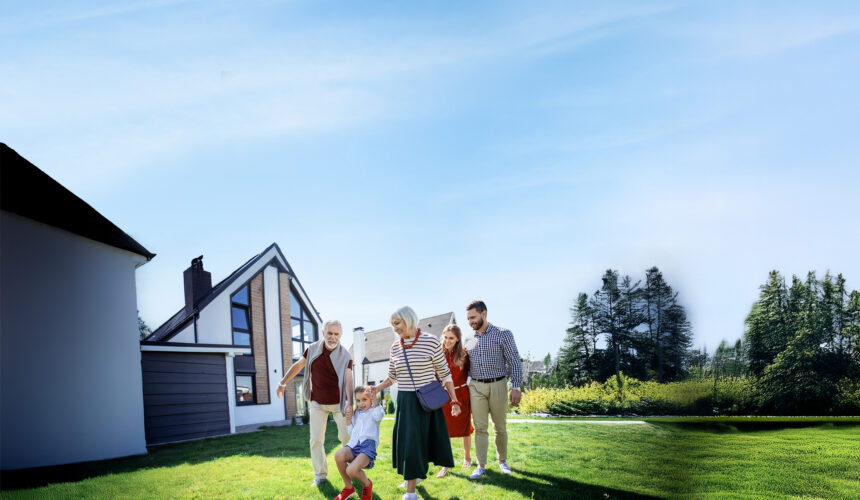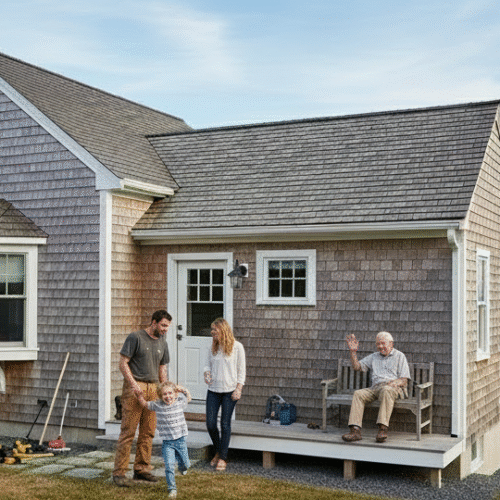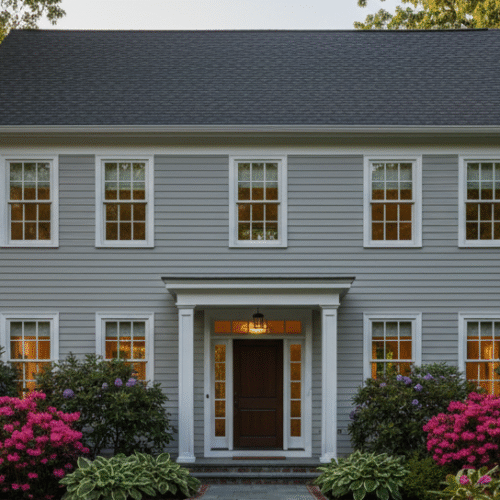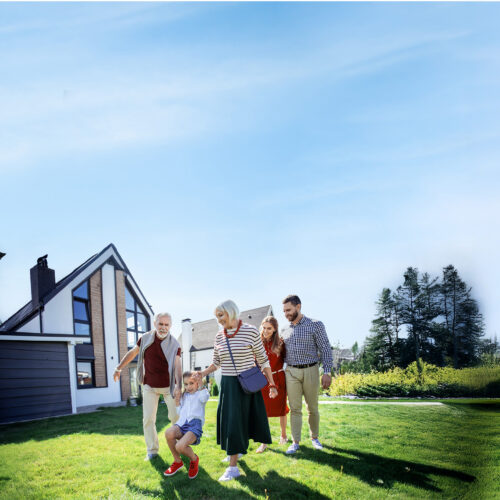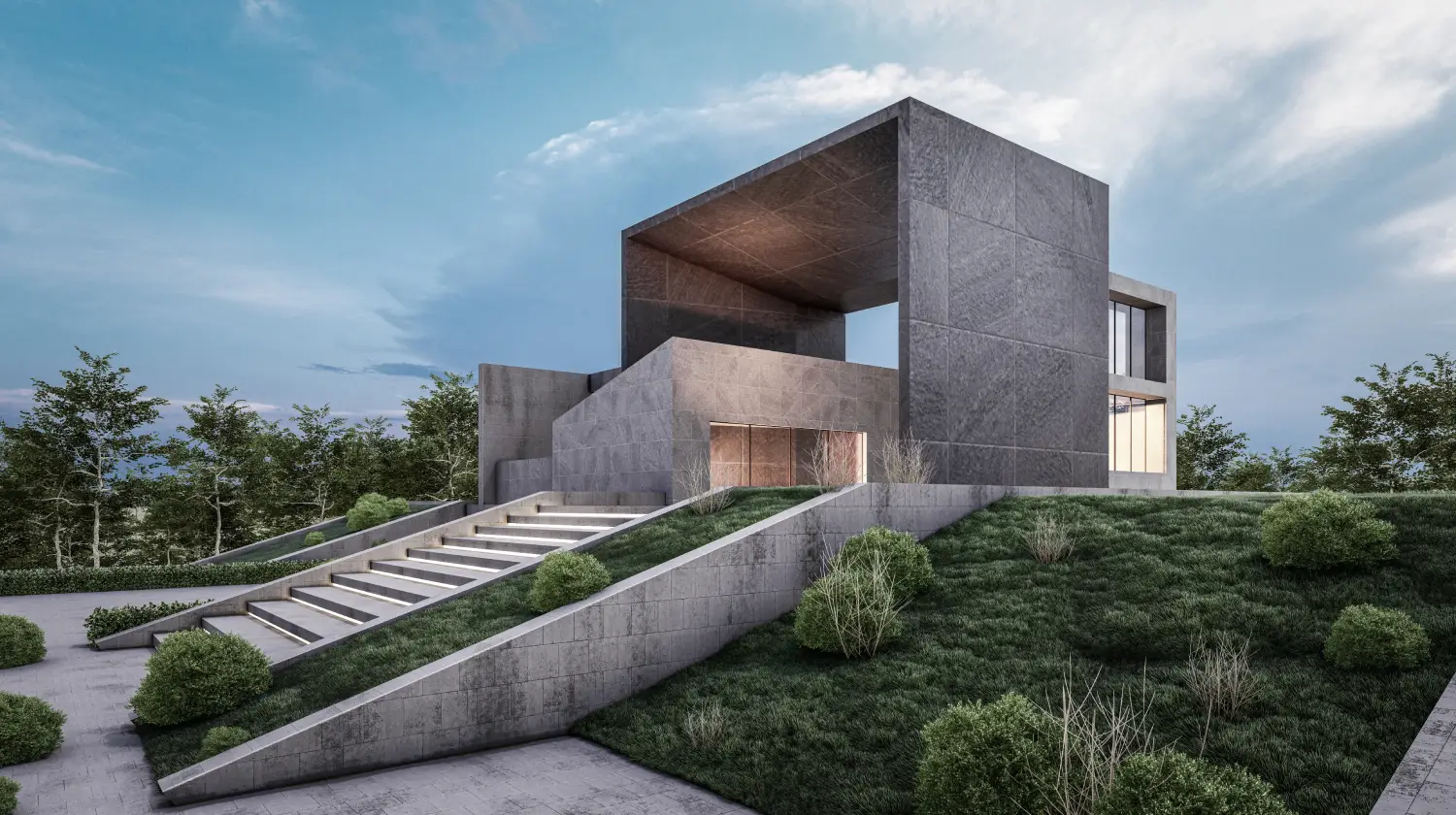Builder Dave Potter compares ADUs for aging parents with rental units. Senior-friendly design focuses on accessibility: lever handles, walk-in showers, blocking for future grab bars, higher toilets, wider doors, task and stair lighting, and paths that allow ramps. Massachusetts requires a separate entrance and local input, so plan placement early. Caregiving ADUs often get higher-end finishes; rental-focused units maximize two bedrooms within the 900 sq ft cap and use durable materials. Many families have parents fund an ADU and move in while children take the main house, while others rent the unit now and reserve it for future care.
John Maher: Hi, I am John Maher. I’m here today with Dave Potter. Dave has been a licensed builder and real estate developer since 1980 and he’s completed hundreds of projects in his career. Now Dave is specializing in accessory dwelling units or ADUs in Massachusetts. Today we’re talking about ADUs for aging parents versus rental units. Welcome Dave.
Dave Potter: How you doing? Good to be here, John.
Features Of An ADU
John: Yeah, thanks Dave. Dave, what are some of the features that would make an ADU senior friendly?
Dave: A lot of them, most of related to handicap accessible, handicap addressable type of thing, and it’s just simple things. Having levers on your doorknobs, having a shower instead of a bathtub, having this capacity blocking to put in grab rails, even if you’re not putting the grab rails in now, at least you can.
What I always do is I always put blocking behind where the grab rails would go and then I mark it and I will have a paper written up saying that’s where they are. In case anybody comes along in the future and wants to put grab rails, they’ll know there’s blocking right behind there. That’s one of the things. A high rise toilet could be there. Kohler makes a nice one and think it’s 19 inches high. These things help Having a vanity that has enough room for somebody to be standing there and holding onto it is, believe it or not, one of those small things that you can do to help somebody.
And that’s lighting underneath the vanity, lighting in the stairs if you have stairs in the ADU that are there so they can see what’s going up. Things like that. Having the three-foot-wide doors or at least 32 inch wide doors going into the bedroom in case they have to be in a wheelchair temporarily or something like that, that can fit through the doorway.
Finances for an ADU
John: And how do the finances for an ADU differ for a rental property that you might be building versus a caregiving type of ADU?
Dave: Usually you can spend more on the caregiving type of ADU because it’s somebody that’s older, that perhaps has more money and they want to have the nice things in there. They want to be able to have the better kitchen or better bathroom fixtures and better luxury moldings and different things like that. And the design is always a little bit more open.
Whereas a rental…the maximum ADU you can build is 900 square feet. You can get two bedrooms in a 900 square foot and still have an ample things there. So, would you do that more or less if you were going to rent it out? No, there’s nothing in the law that says it only has to be a one bedroom or a studio ADU, although predominantly that’s what they are. You can have two bedrooms in a 900 square foot. I’ve even seen three, but that’s probably, you’d have really small bedrooms, but 900 square foot, you can have two bedrooms.
And that’s what you would probably do if you were going to strictly rent your ADU out. You would probably put the two bedrooms and put more sturdy cabinets, but not so expensive cabinets because you’d want to be able to get doors, different things later on if something did happen to them from the rental.
Who Usually Builds ADUs?
John: Do you find that this is usually children with aging parents that are adding onto their home in order for their parents to move in? Or is it often the parents’ home that they’re adding onto as they’re getting older and they’re moving into the new dwelling and then basically selling or giving their house to their children? Which one is more common?
Dave: More the latter than the former. Usually see parents who own the house already, their kids, they want to see their grandkids more. They’re kind of either retired or semi-retired. They have ample funds. Their house is paid off. If it’s not paid off, they just have a mortgage on there just to have a small mortgage on it. But what you see is they’re doing this project so that they can move in and their children can take over the main house and in grand,
John: Maybe it’s a family house that the kids grew up in and they’ve been looking forward to moving back to that town for years or something like that.
Dave: Exactly, exactly.
And that’s what I’m saying, but that’s why they’re spending more money because they’re moving into this unit. So they’re sitting there saying, well, I want to have a fireplace in my bedroom and I want to have the nice shower with the shower heads and a nice beautiful glass door. And some of these shower doors can cost thousands and thousands of dollars, and that’s what they want.
They want to have that stuff and they want to have the nice appliances and different things like that. So they spend a lot of money on these things, but not as much as you would if you were building a brand new house for yourself. So it’s a win-win situation for them. And then the kids get to move into the house that they probably grew up in, them getting to move a house with a yard. They’re getting to move a house in a neighborhood that they can never possibly afford right now. And so they love it.
What Accessibility Design Options That Matter Most?
John: What are some of the accessibility designs that matter most? I mean, you mentioned grab rails and showers instead of tubs. Are there other things that come to mind when you’re talking about accessibility?
Dave: Stairs are a big thing, and you can have some stairs, some people, but if they see three flights of stairs, they’re, we’re not really interested in that. So, you might have, there’s some ideas. Some people, one person wanted to put, they had a basement and they wanted to put a living here in the basement with the first floor, have the kitchen, and then the second floor, they want to do like a townhouse style, had a bedroom. And I said, that’s, I don’t know why you better off it’s being in the whole second floor and making that all bedrooms for the main house and then having maybe the first floor taken a little bit out of the first floor and turning that more into one level living for the long run.
And that worked out there, but it’s kind of, stairs were a big thing, although a lot of people don’t really mind one set of stairs or having some stairs going up. If you do have somebody that’s older that may be coming in a wheelchair, even temporarily say they fall and hurt something, they need to be in a wheelchair just for six months. You want to have the provision of being able to put even a temporary ramp there. So, you want to keep an eye on that part of it when they come out. Is there a three foot wide door to get in there, but is there a deck that you can come out on that you can be even with the door and then that you can put a ramp from the deck to the walkway?
Planning for an ADU
John: So, it’s really important to have some thoughtfulness beforehand in the design process about where is this ADU being put on the house? Is it on the ground level so that there’s no stairs that need to go into it? Does it have its own separate entrance? Do we have the ability to put a ramp, a wheelchair ramp to the door, that sort of thing.
Dave: It’s required by law, the Massachusetts ADU law that every ADU has its own separate entrance. Some towns even say where you can put that separate entrance, they don’t want to face in the neighbor’s yard, they don’t want to face in the backyard. And the fire department has to say, and where you’re going to put that too if they want to know where they’re going in case there’s an emergency. So there’s a lot of little things about the law and little things about building an ADU that have to be ironed out in the planning stage.
Why do Families Build an In-Law Suite?
John: What are some of the things that motivate families the most in building an in-law suite or a suite in their house for their parents?
Dave: Well, one of the big things is it is given access to some older people, kids in their thirties and forties that have kids that are kind of getting shut out of the neighborhoods they want to be in. And so what they’re doing is they’re either moving in there and they’re redoing it and making an ADU there for their parents, or they’re selling their house and using that money to do it.
But usually I see that the parents are funding the whole thing and the children are moving in with the idea that eventually it’ll be their house anyways. But a lot of times you also see younger families doing this and buying, if I do a development, a house or a project and I’ll put an ADU in it, they’ll go in there and they will either rent it out to Airbnb or if it’s allowed by the town or they’ll rent it out just to help them with the mortgage until they get a little bit older. Or maybe their parents aren’t quite at that point where they want to build, but they always have an idea we’re going to bring mom or dad over here in case when the time comes that they can’t live by themselves anymore.
Preparing for the Future with an ADU
John: Right. That’s an interesting consideration that even if your parents aren’t that old yet, you could build a property like this, use it as a, potentially use it as a rental property now with the idea that maybe your folks will move in at a later date.
Dave: I see that a lot.
John: Yeah. Are there any incentives in terms of building an ADU for a caregiving related purpose?
Dave: There are some. I haven’t run into that town of Salem. City of Salem used to have a $25,000 grant, but that would have to go towards the engineering and the architecture for it, not so much into the construction. A lot of those in today’s environment, a lot of the government funding and grants and stuff like that are disappearing, but it still makes a lot of sense to do this even just on its own value.
John: Absolutely. Alright, well that’s really great information, Dave. Thanks again for speaking with me today.
Dave: Thank you.
John: And for more information about Dave and ADU projects in Massachusetts, visit davepotteradu.com or call 66-BUILD-ADU. That’s 662-845-3238.

